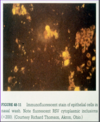Respiratory Viruses II Flashcards
Parainfluenza Viruses
- Paramyxovirus genus of Paramyxoviridae family
- 4 serotypes
- Significant antigenic drift or shift does not occur
Paramyxovirus Structure
- Single-stranded (-) RNA (one linear piece)
- Nucleoprotein covers RNA
- M (matrix) protein surrounds nucleoprotein complex
- envelope contains attachment protein that has both H and N and the fusion protein (F).
- Pleomorphic

Paramyxovirus Replication
- All events occur in the cytoplasm
- Replicates like (-) RNA virus
- Budding through cytoplasmic membranes
Paramyxovirus Clinical Disease
- Infants and young children get more serious illness but older adults and people with weakened immune system also gets sick
- Parainfluenza 1: Major cause of acute croup (laryngotracheitis) in infants and young children.
- Parainfluenza 2: Croup in children
- Parainfluenza 3: Severe bronchitis and/or pneumonia in infants under 1 year of age
- Parainfluenza 4: Least common of the group, generally associated with mild upper respiratory illness.
Paramyxovirus Diagnosis
•Clinical picture, serology, virus isolation, RT - PCR
Paramyxovirus Treatment
•No specific treatment or prevention, serious cases may require supportive care
Paramyxovirus Vaccine
•Nasal spray vaccine under development
Respiratory Syncytial Virus (RSV)
- Pneunovirus genus of Paramyxoviridae family
- 2 serotypes (A and B)
- forms syncytia in tissue culture
RSV Structure
- Same as parainfluenza virus except the envelope glycoproteins are an attachment (G) glycoprotein and a fusion (F) glycoprotein.
- Non segmented (-) ss RNA genome
RSV Replication
•same as Paramyxovirus
RSV Epidemiology
•RSV infection occurs annually from late fall to early spring
RSV Clinical Disease
- Single most important agent of bronchiolitis and pneumonia in infants under 1 year of age
- Can infects children and adults
RSV Transmission
•Transmission by contact with infective secretions incubation period 2-4 days
RSV Clinical Findings
- Spreads from upper respiratory tract and goes down to bronchi, bronchioles, alveoli
- Acute phase of cough, wheezing and respiratory distress lasts 1 to 3 weeks
- hyperexpansion of lungs, hypoxemia, hypercapnia, interstitial infiltrates
- Fatality: 0.5-1.0%

RSV Pathogenesis
- Infection primarily in respiratory epithelium with progression to middle and lower airways
- RSV F protein promotes fusion leading to syncytia formation
- Major factors in pathogenesis:
- Deficit in humoral response to RSV antigens
- Antigen-antibody complex formation within respiratory tract results in complement activation
- Excessive damage from inflammatory cytokines
- TH2 cytokines associated with severe disease
RSV Immunity
•Immunity to reinfection is brief because recovered patients from a primary acute episode are reinfected with the virus
RSV Diagnosis
•immunofluorescence to detect viral antigen in nasal secretions, RT-PCR

RSV Treatment
•supportive, (aerosol ribavirin in selective circumstances)
RSV Prevention
- No vaccine. A monoclonal antibody against F protein (palivizumab) used for prophylaxis in high-risk infants
- Nasal spray vaccine under development
Human Metapneumovirus (hMPV)
- Metapneumovirus genus of the Paramyxoviridae family
- Accounts for 10% of the respiratory tract infection in infants and young children
- Second to RSV to cause acute bronchiolitis with comparable severity and symptoms to those of RSV
- Both RSV and hMPV can infect the same child
- Infection with hMPV occurs in slightly older children compared with RSV
- Diagnosis: RT-PCR (amplification of the viral genome)







